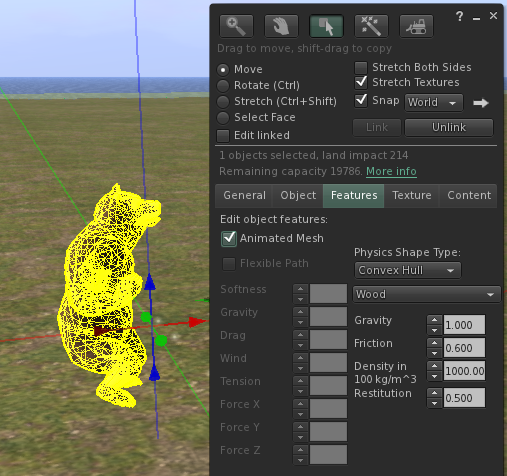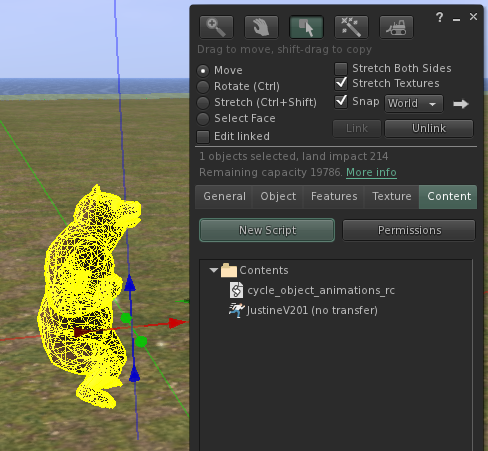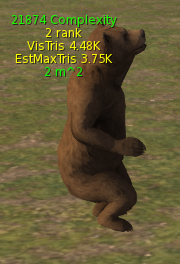Viewer That Lets You Upload Object in Secondlife
Welcome to Animesh! Animesh is a new 2nd Life feature to allow independent objects to use rigged mesh and animations, simply as you can today with mesh avatars. This means that y'all can now have wild animals, pets, vehicles, scenery features and other objects that play animations.
Where information technology works
Animesh is supported in all regions of the chief grid and on the test filigree. Currently Animesh works with the default viewer. If you need a identify to test animesh content, in that location are some dedicated test regions at Animesh1, Animesh2, Animesh3and Animesh4, which are ready to moderate maturity, and Animesh Adult, which is intended for adult content. These regions also have a gift box which volition give you some examination/example animesh objects. All the regions are publicly accessible. Items left in the regions will be automatically returned to you lot after 24 hours, and may be manually returned at any time if we demand to brand changes to the test areas.
Getting started
Visit one of the Animesh regions listed above and look effectually. Hopefully you will see some interesting animated objects! Free sample animesh items are bachelor in all the test regions; just click on the big souvenir box in the centre of whatever region.
The sample animesh objects are a velociraptor, a human, and a teddy bear. All of them can play their own animations and wander around the region using pathfinding. The teddy bear is likewise designed to be used equally an zipper if you want to pick it up.
The respective source files for upload can be plant at Bug-139234
What's new with animesh
Making and unmaking animesh objects
The animesh viewer adds one new feature to the UI for editing an in-world object. If you correct click on an object and choose edit, you volition meet a dialog for editing the object. In the features tab, in that location is a new checkbox labelled "Animated Mesh". If the object is a rigged mesh, y'all tin can use the checkbox to turn it into an animesh object with its ain skeleton. There are some restrictions: the object must be one you have permissions to modify, information technology must not exceed the maximum triangle count limit for animesh objects, and you must exist in an animesh-enabled region. If any of these condition are not met then the checkbox will not be enabled.

Animating animesh objects
When an object becomes animesh, information technology won't do annihilation right away. You still take to run animations on it. The manner you do this is to add together ane or more animations to the object'due south inventory (using the Content tab) and then run a script that plays those animations.

Hither you can come across the animesh object contains one animation, and has a script that can run it.
Animesh adds three new LSL methods that tin can be used to run or stop animations, or check which animations are currently running. The commands are:
- llStartObjectAnimation
- llStopObjectAnimation
- llGetObjectAnimationNames
Details and examples on how to use the methods are given at those wiki pages.
Animesh position and orientation
A conventional static mesh object has a position divers when it'south rezzed, and an orientation divers when information technology'due south created. An animesh object even so has an object position defined "nether the hood", but the displayed mesh is shown at a location determined by its underlying skeleton and currently playing animations. Because of this, the visual location of an animesh object playing an animation may be at some displacement from its "real" position for physics and scripting purposes. The skeleton is positioned relative to the original object every bit follows:
- The object position is used as the location for the skeleton root joint.
- The object orientation matches the root object orientation. If the root object is a mesh, the demark shape matrix will be used.
- Playing animations tin change the visual position and orientation farther by animating the pelvis articulation.
One result is that animesh objects will normally be oriented with their local 10-axis equally the frontward direction. Static mesh objects are not necessarily created in this orientation, so there may be a change in orientation when an object becomes animesh. Yet, if the root object of an animesh linkset is a mesh, the bind shape matrix will also be used. This means that if you want your object to be oriented relative to the static mesh representation, you can use an animesh root mesh. If you want your object to accept standard Ten-forward skeleton orientation, you can use a non-mesh root object (for instance, a elementary invisible prim) and so align your mesh child objects relative to that.
An animesh object's real position and orientation can be edited using the standard editing controls (right click the object and pick edit). Scale changes can likewise be made but have no result on the skeleton, and so are non reflected in the displayed mesh.
Position and Calibration Constraints
There are some constraints on the scale and positioning of animesh objects. These are intended to maintain consistency with limits on other types of in-world objects (such equally conventional prims), and to make the behavior more predictable.
- At that place is a 64m scale limit for animesh objects. Objects exceeding this size threshold will be scaled downward so their computed bounding box does not exceed 64m.
- There is a 3m offset limit for animesh objects. Offset is the altitude between the "official" location of the static object and the bounding box of the animesh object every bit displayed. The brandish location of animesh objects volition exist constrained to non exceed this limit.
These constraints are based on a real-time bounding box maintained for rigged meshes, so they may be triggered at some times and non others depending on the animations being played. For functioning reasons the box does non update every frame, so the constraints tin can lag backside the electric current appearance slightly.
Animesh building suggestions
Animesh objects practice non accept attachments the mode avatars do. To combine multiple meshes in a single animesh, you would link them together into a unmarried linkset. If yous link together multiple meshes, the original source meshes and any corresponding physics representations can be scattered effectually multiple locations. The meshes will all still display rigged to a single skeleton, with orientation as noted to a higher place. The recommended practise for now is to have a root prim that's not a rigged mesh, and associate any physics representation with that root prim. The rigged meshes would then be non-physical children of this root.
Too note that like rigged meshes on avatars, the rigged meshes in animesh objects are non-physical. The animation process just affects how things brandish on the viewer, so if y'all want to accept a physics shape that lines up with your animesh object, you lot will demand to manage the positioning and animations appropriately.
Animesh attachments
Animesh objects can also be attachments on your avatar. Like a conventional static attachment, an animesh attachment volition motility with the selected attachment point on your avatar, such as your right shoulder or left hand. Animesh attachments tin can then run animations, which can change their apparent position relative to their attachment point (for case, if the pelvis joint is office of the animation).
Like static attachments, animesh attachments can be repositioned using the editing controls. Irresolute position or rotation will motility the zipper relative to its attachment betoken.
Currently you tin can accept at virtually one animesh zipper at a time.
Animesh Skeleton State and Customization
Avatars support all-encompassing customization via sliders. The bones in an avatar skeleton are positioned and scaled based on these customization settings, which are stored mostly in the avatar's shape wearable. Animesh objects do not currently support this type of customization; they do not have shape wearables, so in that location is no fashion to practise the aforementioned kind of skeleton customization for them. The bone positions and scales for an animesh object are simply initialized from the default bone settings (divers in some configuration files that are part of the viewer installation - avatar_skeleton.xml and avatar_lad.xml). These default bone positions and scales can be overridden in the uploaded meshes, using values defined when the meshes were created. This is the same articulation position mechanism that rigged meshes can also use to customize avatar positioning.
We know there is a lot of interest in supporting more all-encompassing customization of animeshes, and are hoping to tackle this in a later project.
New and updated displays
Some boosted displays are bachelor to help you see the land of animesh objects:
- In the Avant-garde menu, the option Functioning tools->Show avatar complexity information lets you see the computed complexity toll for avatars. This brandish has some additional information added to it, and now works for animesh objects too.

Here you lot tin run into the updated brandish, applied to an animesh object. VisTris is the number of currently displayed triangles associated with the object, based on the currently displayed LODs (levels of detail) for its component primitives. EstMaxTris is an estimated triangle count for the near complex LODs of the object; this is the number used to determine whether an object exceeds the triangle count complexity limit for animesh objects. The complexity display only works for avatars and independent animesh objects. Attached animesh objects have their complication added to the avatar they are fastened to, then they are not shown with a complexity brandish of their own.
- Some other updated display is Develop->Return Metadata->Collision skeleton. This will prove the collision volumes for animesh objects every bit well as avatars, with the animesh objects shown a different colour:
![]()
Hither the avatar has a bluish skeleton, and the animesh has a cerise 1.
- Develop->Render Metadata->Joints volition show the regular bones in the skeleton of both avatars and animesh objects.
Both of the Render Metadata displays take a significant functioning touch on, so y'all volition probably not desire to enable them most of the time.
Known issues and bugs
- Animesh shadows do non take alpha into account. This is a general graphical issue with how we display rigged meshes, so it'southward the aforementioned as what you would encounter if the same meshes were attached to your own avatar. This is an issue that nosotros are aware of and promise to fix at some signal, simply it'southward not part of the Animesh projection.
- Some types of editing in the build floater do not work correctly with animesh objects.
Warnings
Objects yous place in the test regions may be deleted or returned at any time. Delight keep a copy of all your piece of work in progress.
FAQ
What happens if I accept an unsupported viewer?
If you visit an animesh-enabled region with a non-animesh viewer, y'all will see animesh objects as non-animated static mesh objects, and animesh attachments every bit rigged meshes on the host avatar.
What happens if I visit unsupported regions and endeavour to use animesh content?
This situation should not come up now that animesh support is enabled on the main grid. If you lot practice encounter a region, perchance on the test grid, that lacks animesh support, then animesh objects volition not work correctly. Scripts that try to use the new animesh LSL functions will give an fault message if run in a non-animesh region. Once you return to an animesh region you may need to reset the script to become it working again.
How can study a bug or asking new features?
Please written report the bug using the standard JIRA process, and include [ANIMESH] in the title.
How can I engage with other users of animesh?
- Visit the content creation forum area for animesh: https://community.secondlife.com/forums/forum/354-animesh/. Linden Lab will monitor this area while animesh is under evolution, and we will try to respond to questions of general interest.
- Nourish the Content Creation User Group meeting, which is held most weeks on Th. All are welcome. See https://wiki.secondlife.com/wiki/Content_Creation_User_Group for location and schedule information.
Will any pre-animesh content change?
No. Animesh is a new setting for mesh objects. Any content created without that setting should continue to work the same as before. If yous see whatsoever modify in the behavior of non-animesh objects, please study it equally a problems.
What's the departure between an animesh attachment and a regular rigged mesh attachment? When should I use one or the other?
Animesh attachments have a complete skeleton of their own, and then they tin move completely independently from your avatar. For example, an animesh fairy could flap its own wings separately from the wings on your avatar (this also means that animations between animesh objects and your ain avatar may not be completely in sync, since they are animated independently). An animesh attachment can too become an contained object if it is detached. Regular mesh attachments employ your avatar's skeleton, and so if they desire to animate any part of your avatar they have to cooperate with other attachments. At that place are some cases where you could use either an animated attachment or a rigged mesh: if the object uses joints that are not being used for anything else, for example, it animates the wing bones of an avatar that does not have wings, and so this could exist implemented using either a regular rigged mesh attachment or an animesh attachment.
Are in that location any restrictions on animesh content?
The current limits are intended to aid manage the functioning costs associated with animesh objects:
- There is a limit to how many animesh objects can be fastened to an avatar at i time. Currently this is a maximum of i, two for premium subscribers.
- Animesh objects in-earth (ie, not attached to an avatar) will have a land bear on that counts against the limits for the region they are in. Currently being animesh adds an boosted 15 to the state bear on of an object. There is an additional land impact cost of 1.5 per 1,000 charged triangles in the model. All triangles in the highest LOD are charged, simply only triangles exceeding a limit are charged in the coarser LODs; there is no LI penalty for LODs as long as each does not exceed half the complexity of the adjacent highest level - for example, if the highest LOD has x,000 triangles, yous could make LODs with no punishment upwards to 5,000 triangles in the medium LOD, 2,500 in the low LOD, and 1,250 in the lowest LOD. LODs that exceed those limits will exist counted against the LI simply for whatsoever excess above those limits.
- Animesh objects take a complexity limit based on triangle count. Currently an animesh object can take at near 100,000 triangles in its almost detailed LOD. This 100,000 limit is based on estimated triangle count, and then the bodily number of triangles tin can often be a flake college.
- Attached animesh objects, like other attachments, do not count against land impact. However, they do affect the Avatar Rendering Toll calculations for the avatar they are attached to. The ARC for animesh objects, like the ARC for avatars, incorporates the effects of graphics properties of the mesh objects, and is scaled to exist roughly proportional to the country impact - for example, if an animesh object has 50% higher state bear upon than the corresponding static mesh, then the ARC for that animesh should too be roughly 50% higher.
Boosted resources
Hither are a few links to resources related to animesh:
- Second Life Blog: Animesh is Here!
- Content Creation User Group
- Content creation forum area for animesh
gilmoreyouresser1972.blogspot.com
Source: https://wiki.secondlife.com/wiki/Animesh_User_Guide
Postar um comentário for "Viewer That Lets You Upload Object in Secondlife"